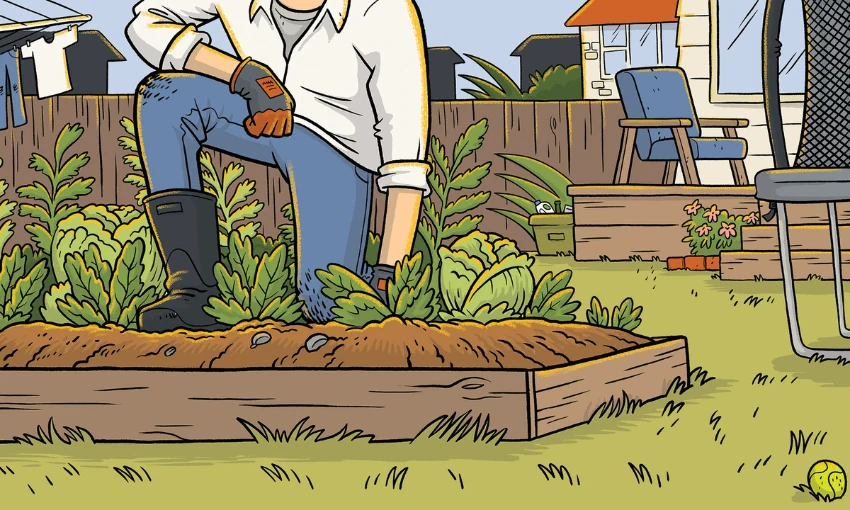By Ellen Rykers
Copyright thespinoff

A multi-year trial to heal the soil on a Gisborne vege farm yielded promising results. Can home gardeners replicate regenerative techniques at a backyard scale?
When Catherine Langabeer’s daughter started a Garden to Table gardening programme at school, they were inspired to put some vege beds in the backyard at home. Salad greens, herbs, radishes, snow peas and broad beans went in, and nipping out before dinner to harvest some fresh greens or a sprig of herbs became a ritual.
Langabeer’s family opted for a “no dig” approach to their vege patch. This means leaving the soil undisturbed as much as possible, and layering on a thick rich frosting of compost.
You can still dig little holes to plant seedlings in a no-dig garden, but the idea is to put the spade aside and keep the soil structure (and carbon) intact. Let the complex ecosystem of soil microbes and earthworms do their thing, recycling nutrients. Think: you’re not just growing plants, but growing healthy soil – and all its resident critters too.
“The connection from grower to table, it’s so important,” says Langabeer, head of sustainability at Woolworths New Zealand. “If you have an opportunity to do that in your backyard, I think it heightens your appreciation of what it takes to produce food at scale.”
This soil-first approach was partly inspired by Langabeer’s experience in an ambitious experiment to supercharge soil health on a much bigger stage: a commercial vege farm in Gisborne.
In a three-year project, LeaderBrand – growers of the majority of New Zealand’s spinach, lettuce and leafy greens, as well as other fresh produce like sweetcorn, broccoli, cabbage, grapes and squash. – partnered with Woolworths and scientists at Bioeconomy Science Institute, to test out techniques for healing hammered soil.
Across Aotearoa, soil quality has reduced under repeated cropping. Conventional farming methods have churned it up and squashed it down. Left it bare, rootless and exposed to the elements. Organic matter, or carbon, has been depleted, leaving the soil running on empty. Regenerative agriculture (or regen ag, for short) could offer a way to nourish the soil – a regenerative revegolution, if you will.
Over two years, the trials implemented compost and cover crops in a regenerative zone, then monitored the soil health and crop yields and compared them to a conventional paddock. Compost is a nutrient-rich superfood for soil, while cover crops are planted out to keep the ground covered in between “cash” crops harvested for sale and eating. Rather than being picked, cover crops are incorporated back into the earth to provide a carbon-snack for soil microbes.
Matt Norris, soil scientist at the Bioeconomy Science Institute, thought it would take much longer than two years to see improvements. He was pleasantly surprised: the soil’s physical structure improved – less clods, more thick crumbles – and signs of active microbial life skyrocketed, fuelled by an increase in carbon.
But you don’t have to be a commercial vege grower to reap the rewards of regenerative agriculture. Growing anything, anywhere – from raised beds to pots – comes down to the soil and how you look after it. You’re not just growing veges, you’re growing a whole soil ecosystem.
“In a home garden, these principles translate and it’s a lot easier to do,” says Norris. “If you get something wrong, it’s not the end of the world.” But where to begin?
Soil assessment
If you’re ready to channel your inner soil scientist and become an earth whisperer, start by asking – how is my soil doing right now? To answer that question, Norris recommends making a simple visual assessment.
Extract a spadeful of soil, then get up close and personal – what does the soil look like? Is it compacted into a dense clod? Does it have more of a crumbly texture? Or does it slip through your fingers like sand? Healthy soil has well-distributed nut-sized crumbs. This structure is essential for soaking up water and resisting erosion. It offers room for roots, space for air and habitat for critters.
Now, lower a clump of your soil into a clear container of water, and watch. Does the water remain fairly transparent, or does it immediately cloud up? Clearer water indicates that the soil is more resilient, loaded with natural “glues” like organic matter and fungal webs that help it stick together. Murky water means the soil is more fragile and lacks internal structure.
Finally, check for earthworms. These hardworking ecosystem engineers create tunnels that improve airflow and drainage. They munch through the soil’s organic matter and poop it out as nutrient-rich plant food. More earthworms indicates healthier soil.
Now that you’ve assessed your garden’s vital signs, it’s time to cultivate a soil-care routine to lay the groundwork for flourishing veges. Here are three key ways to do this.
Cover crops
Just like cover crops on the LeaderBrand farm, always ensure you have something planted in the soil rather than leaving it bare. “Think, what could I grow in winter?” says Norris. “Like broad beans, or something that’s just in the soil, growing and actively contributing to that carbon input.” Keeping the soil covered – above, and below with roots – helps retain moisture and slow down erosion. Plus, if you plant legumes like peas and beans, these nitrogen-fixing powerhouses can further boost soil health. They make a pretty yummy snack too.
Crack into the compost game to add carbon-rich organic matter that will feed your soil microbes and boost the carbon-storing superpowers of your soil. Gordon McPhail, general manager of farming at LeaderBrand, is “massive on soil health” – even though he isn’t much of a gardener at home. “I’m like those builders who never fix [their own] house,” he laughs. “I’m lucky my wife absolutely loves gardening. She has a greenhouse and garden patches.” The couple make their own compost.
If you’re ready to make your own compost, there are several composting systems to choose from. There’s even one that can be used in apartments. The classic backyard compost bin, meanwhile, requires about four months of adding food waste, cardboard and garden waste to produce a rich “humus” crumb for your garden. Or you could opt for a worm farm, and gather worm castings (aka poo) and brew worm “tea” to beef up your soil’s nutrients. You can also buy compost from gardening centres and community gardens.
‘No dig’ and beyond
Like Langabeer, you can also try a no-dig approach – it’ll be gentler on the soil, the soil-dwelling communities and your back.
The regen ag toolbox is full of ideas to play with. You can also consider, for example, reducing or eliminating pesticides in your garden. Other regen tools and tricks actually go beyond soil health, too. The project in Gisborne investigated what native plants might attract farmer-friendly insects, aka “natural enemies” that keep pest numbers in check. In your own garden you can explore companion planting. Consider the placement of different plants and flowers to attract beneficial pollinators, or lure pesky vege-munchers away. The smell of celery, for example, keeps cabbage white butterflies at bay, protecting your caulis, broccoli and beans.
Regardless, McPhail’s ultimate advice for regen-curious home gardeners is simple: just start.
“That’s the cool thing about regen, there are no rules,” he says. “It’s just, let’s be better than yesterday on our soil.”



